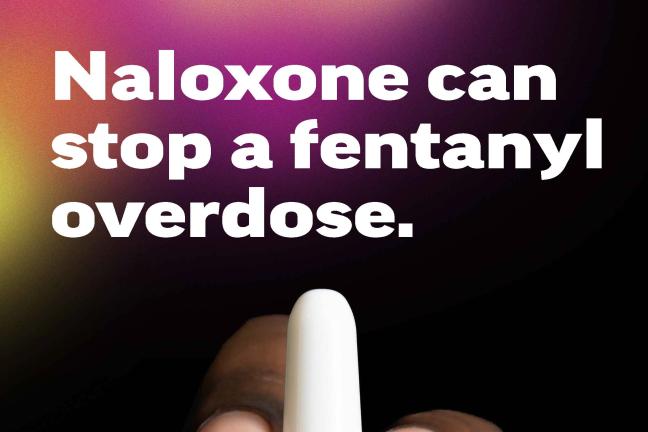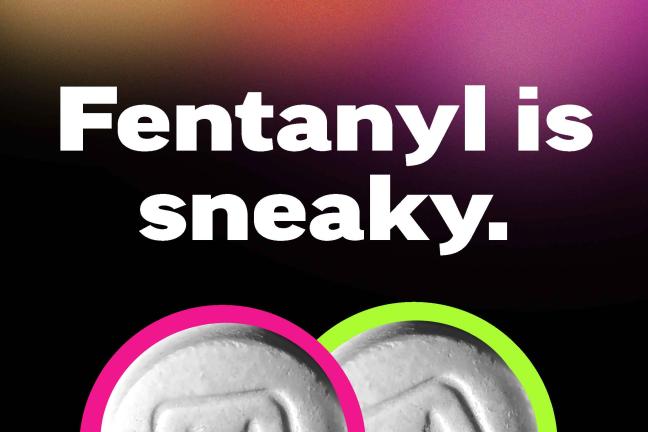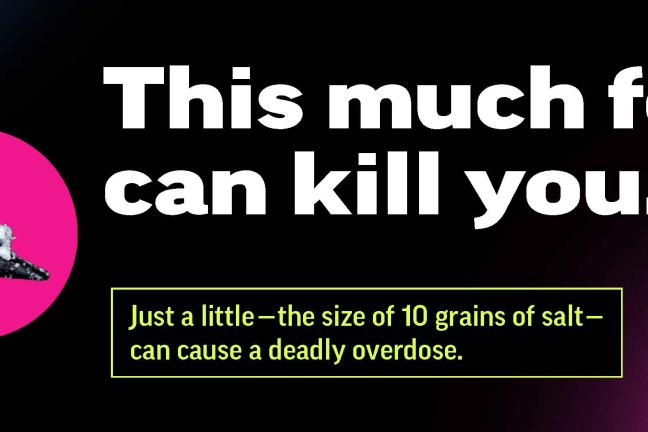The Multnomah County Health Department launched a fentanyl awareness campaign this week, focused on preventing young people from initiating use and dying of drug overdoses. The campaign, which is part of the County’s 90-day emergency response, centers on education and awareness for Portland-area youth ages 13-20.
Messages will appear on bus benches and bus shelters across the County starting on June 13. Digital assets on social media and streaming apps launched the week of May 1. The theme of the campaign, “Expect Fentanyl,” highlights the dangers of fentanyl and how common it’s become for counterfeit prescription pills to contain the deadly drug. In 2023, 7 out of 10 fake pills seized by the Drug Enforcement Administration contained a potentially deadly dose of fentanyl. Fentanyl is approximately 100 times more potent than morphine and 50 times more potent than heroin. A potentially lethal dose of fentanyl is 2 mg, or about the size of 10 grains of salt or the tip of a pencil.
“We know young people are uniquely vulnerable to misinformation about fentanyl, creating a serious and deadly issue that we’ve been working hard to combat on many fronts,” Multnomah County Chair Jessica Vega Pederson said. “Reducing youth exposure to fentanyl and preventing untimely and tragic overdose deaths must be a primary driver in our work to address this crisis. This campaign is the help, awareness, and further education young people and their families need.”
In 2021, 77 percent of drug related overdose deaths among adolescents across the country involved fentanyl. The New England Journal of Medicine reports an average of 22 teens between 14 and 18 years old died in the U.S. each week in 2022 from drug overdoses driven by fentanyl in counterfeit pills.
“If 22 teens are dying each week from drug overdose, that means we are losing almost one classroom of young people a week across this country,” Multnomah County Health Department Director Rachael Banks said. “We must do everything we can to change that.’’
Between 2018 and 2022, there were 1,406 fatal overdoses from all drugs among residents of Multnomah County. Young people aged 15 to 24 accounted for 6% of the total overdose deaths, or 80 out of 1,406 total deaths, according to CDC data.
“Deaths are rising even as teen drug use overall is going down,” Banks said. “It’s unacceptable — for teens, for their families and their communities, and for us.”
The “Expect Fentanyl” campaign will run through early October to reach students at the beginning of the 2024-2025 school year. Youth will see social media videos on Instagram, Snapchat, YouTube and TikTok about the dangers of fentanyl and how to protect themselves and their peers. The campaign will also include streaming audio ads on Spotify and Pandora, as well as billboards and advertising on bus shelters and benches near area high schools to reach young people on their commute to and from school. The campaign will provide posters, flyers and handouts for use by schools and youth-serving organizations.
The Health Department contracted with Coates Kokes, a Portland-based strategic communications agency, to develop the campaign for $86,500. The Health Department will also be spending $98,284 on targeted media advertisements through October 2024. The total cost of the campaign, including the advertisements, is $184,784.
What youth and families should know about fentanyl:
- Fentanyl appears in a variety of forms, including pills and powders.
- You can’t see, smell, or taste fentanyl when it’s mixed into other drugs.
- Fentanyl can be hidden in all kinds of drugs, including street drugs like meth, cocaine or molly, and in pills that look like prescription pills such as Xanax, Adderall, Percocet, or OxyContin. The fake pills often look exactly like the real ones.
- Expect any pill not from a doctor or pharmacy to include fentanyl.
- Naloxone is a nasal or injectable medicine that can stop a fentanyl overdose. NARCAN® is a nonprescription brand of the generic nasal naloxone.
- Carry naloxone to protect others. Anyone can carry and use naloxone. No special training is required. Make naloxone a part of your family's medicine cabinet or first aid kit.
- Signs of an overdose may include an inability to wake up, slow or no breathing, choking or gurgling sounds, blue or gray fingernails or lips, and cold, clammy skin.
- If you suspect someone is experiencing an overdose, call 911 and follow their instructions. Administer naloxone if it’s available. Stay with the person until help arrives.
Naloxone is also available free to students ages 15 to 18 at high school Student Health Centers throughout Multnomah County. Students under the age of 15 can get naloxone with parental consent. It is also available at Health Department Community Health Center pharmacies for clinic patients. Naloxone can be purchased through major pharmacies and is covered at least in part by most health insurers, including the Oregon Health Plan. People who use drugs can also get naloxone and fentanyl test strips through the Health Department’s Harm Reduction Clinic.
Oregon has a Good Samaritan Law, which provides legal protection to anyone helping someone experiencing a drug overdose. People who call 911 or seek medical care when they experience an overdose or witness someone else experiencing an overdose cannot be arrested or prosecuted for:
- Possessing drugs or drug paraphernalia
- Being in a place where drugs are used
- Violating probation or parole related to #1 or #2
- Outstanding warrants related to #1 or #2
Oregon law also provides legal protections for administering naloxone.
Free support for kids and young people (21 and under) experiencing challenges with substance use and/or mental health is available through YouthLine, a confidential teen-to-teen crisis support helpline.
Youth and families in Multnomah County can find additional resources online.



